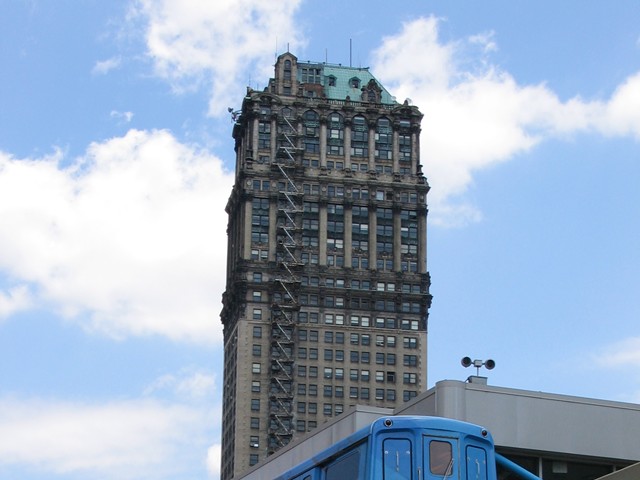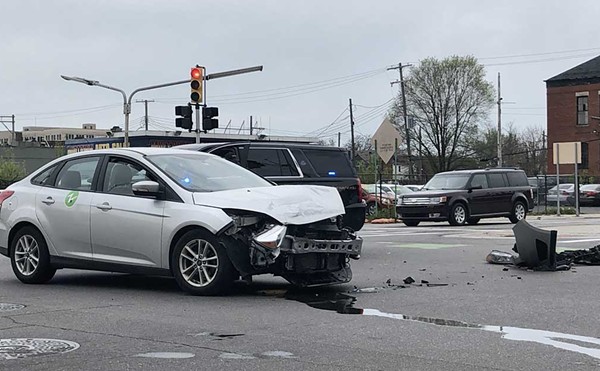This afternoon, the Detroit Free Press republished a 1982 story from its archives on the then-imminent closure of downtown's J.L. Hudson's building. It's impossible to gloss over some of the eye-popping figures provided in the piece: Over 500,000 items were sold at any given moment across 25 floors and four basement levels; the size of the building rivaled Macy's Thirty-fourth Street store in New York City. It was an enormous, cherished space in the downtown skyline.
But the decision to eventually close the building was nearly three decades in the making: As the Freep's story recalled:
[W]hen Hudson's opened Northland, the nation's first suburban shopping center, downtown sales began to fall. In 1970, sales had dropped to $99 million; in 1975, they were down to $75 million. By 1981, sales were $45 million.After sitting dormant for 16 years, a decision was made to implode the department store, a rather unfortunate move considering efforts in recent years to revive a glut of previously under-used historic structures in downtown Detroit.
The growing number of suburban malls — including Northland, Eastland and the Fairlane Town Center — gradually lured away potential downtown customers and helped spur the decline of the landmark store.
The malls also contributed to the demise of Hudson's largest competitors. The Kern department store closed in 1959, and the downtown Crowley's store folded in 1977.
The drain of people and money from the city had similar effects on other retailers. From 1958 to 1972 Detroit lost 7,200 retail businesses — 42 percent — and 32,000 jobs, according to a 1980 study for the Cadillac Center — a proposed shopping center on the site of the Hudson's store.
The timing to republish the piece caps a remarkable story that has come full-circle: Today, Northland Mall is on the brink of collapse, while downtown continues to witness an influx of new residents and businesses. Malls, in general, are a dying concept.
Still, the former Hudson's site remains a vacant eyesore that only serves as an underground parking garage for downtown employees and visitors. An architect selected by the 2-acre property's owner, Quicken Loans founder Dan Gilbert, does have plans to deliver a future concept for the site.
It's certainly possible some newcomers gawk at the site with abject contempt, wondering why the city delivered a wrecking ball to a building with no plan to replace it. Why create a gaping hole in downtown just for the hell of it?
This all directed our attention to a piece MT scribe Curt Guyette penned back in 1998. Even as a developer with a stellar record came forth with plans to renovate and maintain the building, a private group of downtown business reps, then called the Greater Downtown Partnership, went about gathering enough support to see to it that the Hudson's building was demolished. From Guyette:
But as late as November, Larry Marantette, the former ANR Pipeline executive who runs the Partnership's daily operations as its president, told the Metro Times that viable plans to renovate the building would still be considered. Preservationist groups were being told the same thing.
But when a developer with a proven track record for transforming broken-down historic buildings into trendy apartments, offices and shops did come knocking, the brush off was quick and decisive. The Partnership wasn't interested. And when that same developer — Randy Alexander of Madison, Wis.— persisted by taking his case to the City Council, the Partnership flexed its considerable muscle for the first time.
After listening to Alexander's pitch, the council began expressing reservations. There was no plan to replace Hudson's. Did the city want to create a gaping hole in the heart of downtown without knowing what, if anything, would replace it?
In public the Partnership's Marantette worked in concert with Beth DunCombe, president of the Detroit Economic Growth Corp. and the de facto operations chief of the city's Downtown Development Authority. They did their best to shoot down Alexander's proposal. Appearing before the council, they said Alexander's plan wasn't feasible, would cost more than he said, that the public subsidy would be higher than he claimed.
Unswayed, the council called for a public hearing.
Then the Partnership began maneuvering. Marantette met behind closed doors with seven of the nine council members. What he said isn't known exactly: reports vary, with council members saying he did everything from outline broad, vague plans for the lower Woodward corridor to name specific developers interested in the site.
Whatever he said was effective. Less than a week later, with no advance notice, the council suddenly made a 180-degree shift and voted to tear the building down.
Guyette wends his way through a maze of gathering hard-to-find documents and delivers a stirring narrative on how the Greater Downtown Partnership came to exist, and its subsequent, successful effort to demolish the Hudson's building, ostensibly, in the name of progress.






